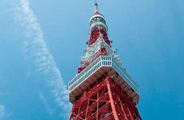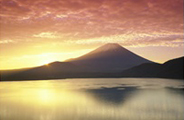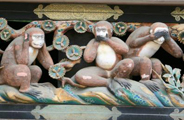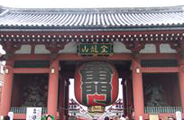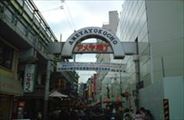It’s not just about watching performances!
The rebirth of “Kabukiza” as a tourist spot

“Kabukiza” is the world’s only theater that specializes in kabuki. With its reopening this spring, the charm has increased not only inside the main hall, which only those seeing performances can view, but also outside of it, an area where anyone can enter. The venue has evolved into a complex that people can enjoy even on days when they have no time to watch a performance. We will introduce the highlight tourist spots of the reborn Kabukiza.
An exhibit that makes it easy to get acquainted with the charm of kabuki,
“Kabukiza Gallery”
A new spot-the largest feature outside of the main hall--is “Kabukiza Gallery” on the fifth floor of “Kabukiza Tower.” Here, you’ll find actual costumes, props, dogucho (stage plans) that you can't normally see, and more, displayed in a style that makes it easy for even beginners to get acquainted with kabuki. It’s like a kabuki wonderland!

This is an exhibition called “SUMMER Color and Sound.” General admission is 500 yen (preschool children are free) and group entrance is 400 yen apiece (20 people or over). The exhibit goes through September 1.
When we went to check out the venue, an exhibition called “SUMMER Color and Sound” was being held. Stage designs such as waves and waterfalls are boldly laid out, and the exhibition space is colored in a vivid blue. In addition, the costumes, such as yukata, emit an added feeling of coolness, allowing you to enjoy the visual effects of summer in a fashion only kabuki can achieve. At “Kobikicho Hall” in the interior of the exhibition hall, you are sometimes allowed to touch musical instruments, which express such ideas as the sounds of waves and afternoon showers, as well as the croaking of frogs.
At the Kabukiza Gallery, with your eyes and ears, you can experience the expressive power of kabuki as a total work of art. From September 12, an exhibition with a fall theme will be held.

At “Kobikicho Hall,” musical instruments used on stage are displayed. You will be amazed by their expressive power.

In “Kobikicho Hall,” there are stages that reuse stage boards from Kabukiza before the renovation project. The powerful matsubame (painted pine tree scenery) also makes an appearance.

At “Elegance of Kabuki SPRING,” which was held until June, cherry blossom hanging from the ceilings colored the gallery.

This illustrates another exhibition from “Elegance of Kabuki SPRING.” You could see beautiful props such as folding fans from up close.
Kabukiza Gallery
4-12-15 Ginza, Chuo-ku, Tokyo Kabukiza Tower 5F
Phone: 03-3545-6886
Hours of Operation: 10 AM - 6 PM (final entrance 5:30 PM)
Closed: New Year holiday, exhibition replacement periods
https://www.shochiku.co.jp/play/kabukiza/gallery/
Come in contact with deep-rooted kabuki culture at the
“Rooftop Garden” and “Studio Alice Kabuki Photo Studio”
The area surrounding Kabukiza Gallery is full of more spots that convey kabuki culture. In particular, the “Rooftop Garden” area, which you can enter free of charge, is a tourist area that matches the Kabukiza Gallery in popularity.

This is the Rooftop Garden, woven with seasonal beauty. Items such as “Senjin no Hi” (stone monument of the ancestors), which pays tribute to great actors, as well as a stone lantern that was in the old residence of Mokuami Kawatake, a kabuki playwright, are found here.
It is important to mention that the Rooftop Garden is spread across a large rooftop that symbolizes Kabukiza. If you were enchanted by the awe-inspiring exterior of Kabukiza, how about viewing the magnificent rooftop that lies before you from the “Goemon Stairway,” which descends four floors from the garden?
After descending the Goemon Stairway, what lies ahead is the “Fourth Floor Corridor,” also free of charge. Panels showing great actors, now deceased, as well as models of successive generations of Kabukiza, are on display, and you can feel a part of the history that the world of kabuki has built up.

This is the “Goemon Stairway,” painted scarlet, the base color of Kabukiza. Many people stop here to view the large rooftop.

At the “Fourth Floor Corridor,” items such as models of the successive generations of Kabukiza are displayed.
Rooftop Garden
4-12-15 Ginza, Chuo-ku, Tokyo Kabukiza Tower 5F
Hours of Operation: 10:00 AM - 7 PM
Open all year
If you’re looking to create a lasting memory, look no further than “Studio Alice Kabuki Photo Studio” on the fifth floor! Here, you can fully transform into a kabuki actor and have your picture taken. Both the costumes and the backgrounds were created by craftsmen who actually do stage work. Quality guaranteed!


On the left is “Waka-zamurai (Young Samurai),” and on the right is “Hagoromo Shinzo (Young Woman in Plumage),” both year-round regulars on the costume menu. For a plan with makeup, the arrangement fee (including a wig, makeup, and a costume) and photography fee is 15,000 yen for the pair. There is also a merchandise fee in order to make the pictures. You will need around three to four hours. There are also plans with lower monetary/time requirements.
Studio Alice Kabuki Photo Studio
4-12-15 Ginza, Chuo-ku, Tokyo Kabukiza Tower 5F
Phone: 0120-137-753
Hours of Operation: 10 AM - 7 PM
Open all year
http://www.studio-alice.co.jp/amusement/kabuki/
There are also plenty of gifts and gourmet items!
“Kobikicho Square” and “Kabuki Soba”

This is “Kaomise,” designed based on the concept of restaurants and gift shops from Shibai-machi (a playhouse area during the Edo period).
Gifts and gourmet items are always focuses for travelers, and with the renewal, these two areas have also gained more appeal. At “Kobikicho Square,” which is on floor B2F and directly connects with Higashi-ginza subway station, there are shops and restaurants. There are also stalls lined up that sell limited edition items that are collaborations with well-established Ginza businesses.
Within those establishments, a shop called “Kaomise” is getting special attention with its wide variety of charming gifts such as kabuki goods, Japanese-style sundries, and Japanese confectionaries. We hear that for customers from abroad, tenugui (ornate Japanese hand towels) are especially popular, as are letter sets for use while on vacation.

“Tenugui (ornate Japanese hand towel),” 1,050 yen. One of the top sellers that features rich designs.

“etter Set” popular with travelers from abroad, 840 yen.

“Kumadori-ame,” a sweet gift synonymous with Kabukiza, 200 yen.
Kaomise
4-12-15 Ginza, Chuo-ku, Tokyo Kabukiza Tower B2F
Phone: 03-3545-6564
Store Hours: 10 AM - 7 PM
Open all year(No performance on the last day of each month.)
http://www.kabuki-za.co.jp/miyage/

“Za Makunouchi Bento,” 2,000 yen. It is filled with flavors adored by Japanese people.
At “Yagura,” also in Kobikicho, we recommend “Za Makunouchi Bento.” This is orthodox Kabukiza gourmet that continues the tradition from the Edo period of eating a makunouchi bento (literally “intermission boxed lunch”) during the performance interval.
Yagura
4-12-15 Ginza, Chuo-ku, Tokyo Kabukiza Tower B2F
Phone: 03-3545-6576 (10 AM - 6 PM)
Store Hours: 9 AM - 7 PM
Open All Year
http://www.kabuki-za.co.jp/eat/yagura.html
Speaking of Kabukiza gourmet outside the main hall, one can’t forget “Kabuki Soba”! Before the renovations, this restaurant was located to the left of the main entrance of Kabukiza, but it has since moved to a building behind the theater. Around lunchtime, queues of people are inevitable. There’s an anecdote that frequent customers who wanted the restaurant to keep going searched out its current location, showing just how fervently popular the place is.

This is the famous “Zaru Kakiage Soba” (soba on a sieve with deep-fried items), 490 yen. It's characterized by the richness of the soup and the deep-fried items, which are separated into small pieces so as to be easily eaten.

The eating area is small, with only a counter. Sometimes kabuki actors come here for a quick bite.
Kabuki Soba
4-12-2 Ginza, Chuo-ku, Tokyo
Phone: 03-3543-4510
Store Hours: 9 AM - 6:30 PM (last order 6:15 PM)
Closed: Saturdays, Sundays, holidays
http://www.kabuki-za.co.jp/eat/outside/soba.html
We also want you to see kabuki.
This time, we did a feature on how to enjoy the area outside of the reborn Kabukiza’s main hall. But of course, the true substance of Kabukiza lies in watching the performances. We’ll introduce the main points of watching performances for guests from abroad who have never seen kabuki before.
“How about tickets?”
→You can reserve them on English sites, too!
Besides the theater ticket vendor, play guides, etc., you can also reserve tickets on English websites. Performance information is also written in English.
> Kabuki Web
“What is the etiquette for watching performances? ”
→There are no special rules.
There’s no particular dress code; you'll be OK wearing what you would wear for normal plays. The rules for watching the performance are also the same as other plays: such as turning off your cell phone.
“Understanding it seems difficult... ”
→Even if the detailed plot eludes you, you can enjoy the experience.
Even if you don’t understand the plot, kabuki will enchant you with its worldview, colored by the manner of the actors, the stage design, and the sounds. There are even Japanese people who enjoy kabuki without understanding the lines.
“I don’t understand Japanese. ”
→There are guide earphones with English, too!
If you use an earphone guide, which has an explanation of the story, background, and direction aims for each scene, you can enjoy the performance on a deeper level. At Kabukiza, you can rent English Earphones Guide.
“Are there really no actresses? ”
→The Onnagata acting is a must-see!
Kabuki actors are all males, and actors who portray women are called Onnagata. The expression of femininity in the Onnagata acting is one of the highlights of kabuki.
”I want to watch a sample. ”
→You can also watch just one scene.
The time for one performance runs from three to five hours. There is popular seating, available only at Kabukiza, called hitomakumiseki (one scene seating), where you can watch just a portion at a reasonable price. For this seating, you do not need a reservation-you line up and buy a ticket on the day.
October Kabuki Program

October 1st (Tuesday) to 25th (Friday), 2013
Full-length perfomance of Yoshitsune Senbon Zakura(Yoshitsune and the Thousand Chery Trees)
Matinee: From 11 AM
Act 1 Torii Mae⁄ Act 2 Tokalya,Daimotsu no Ura⁄
Act 3 Michiyuki Hatsure no Tabi
Evening Show: From 4:15 PM
Act 4 Konomi,Kokingo Uchijini⁄Act 5 Sushiya⁄
Act 6 Kawatsura Hogen Yakata
At Kabukiza, along with the new opening, grand opening performances will continue until March 2014. It’s the perfect chance to enjoy great popular classics of kabuki!



















